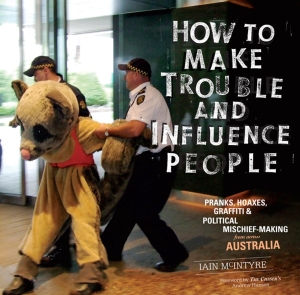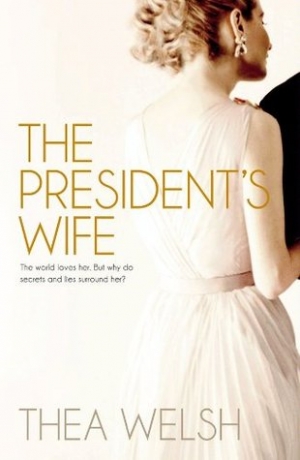Archive
Dan Rule reviews 'How to Make Trouble and Influence People' by Iain McIntyre
Poor communication has long been activism’s Achilles heel. Engaging the wider populace and influencing opinion rely as much on the effective, reliable delivery of a message as on well-organised ideas and events. We may be loath to admit it, but intelligent public relations can aid any pursuit – advocatory, activist, or otherwise.
It is from this perspective that the expansive new publication How to Make Trouble and Influence People: Pranks, hoaxes, graffiti & mischief-making takes its cue. Compiled and written by Melbourne writer, zine-maker, and community radio presenter Iain McIntyre, this vividly illustrated volume documents not only an unofficial history of Australian protest, activism, and all-round cheek, but the connections between political trouble-making and its ability to influence popular opinion. It succeeds, for the most part.
... (read more)Holden Caulfield is a garrulous bore. Seymour Glass is a phoney. Franny and Zooey are spoiled brats. And J.D. Salinger is a media tart. All these things are partly true. To take the last first: there is surely a ring of truth about Imre Salusinzsky’s recent spoof obituary in which Jay Leno and David Letterman are quoted expressing their sadness at the loss of a favourite regular guest who was always ready to front up and sparkle as he promoted an endless succession of Catcher in the Rye merchandise. Salinger, who died on January 27, aged ninety-one, may not have done such things, but at least one of his alter egos might.
... (read more)Shira Nayman’s first novel is full of echoes and resonances. There may even be an echo of Bernhard Schlink’s The Reader. Set at more or less the same time, The Listener has the same immediate backdrop: World War II, its atrocities and aftermath.
Two years after the end of the war, Dr Henry Harrison – the narrator and listener of the piece – encounters a man who will become his most memorable case. Dr Harrison is the director and chief psychiatrist of Shadowlands, a private mental hospital located at White Plains, not far from New York. The exclusive institution is grand, more of a country club than an asylum, with beautiful buildings, extensive woods and formal gardens. Inmates, though voluntarily committed, are known as ‘patients’, not the more egalitarian ‘clients’ or euphemistic ‘guests’ of the present day. Many of them are suffering from war neurosis, a condition that Dr Harrison has been treating for many years. During the war he was required to treat mentally disturbed or shell-shocked officers and to send them back, supposedly cured, to the front. This was to ‘staunch the wastage’, according to the army. Over time he has come to doubt the efficacy of this treatment. By researching complex cases such as that of Bertram Reiner, he seeks to refine his methods.
... (read more)Judith Armstrong reviews 'The President's Wife' by Thea Welsh
It is surprising how many people seem to think that reviewers read only the first and last chapters of books to which they will devote several hundred words of critique. They look sceptical when informed that critics read every word of, and often go beyond, the featured book, searching out earlier works by the same author or books on the same subject by other writers. Thea Welsh being previously unknown to me, I have now read one of her earlier novels, and a memoir, but not her prize-winning first novel, The Story of the Year 1912 in the Village of Elza Darzins (1990).
The memoir, The Cat Who Looked at the Sky: A memoir (2003), was about ‘three cats, two households and the great truths of life’, according to the blurb. It does not appear to have much in common with Welsh’s new novel, The President’s Wife: Welcome Back (1995), however, was very relevant. Briefly, the novel is about Janey, an upwardly mobile Sydney woman who harnesses fierce ambition to more than one stroke of luck in her pursuit of a cherished goal. This is to become president of the charity committee that puts on Sydney’s social event of the year, the élite and glamorous Goldfish Ball. Although Janey is considered ‘too young’ and inexperienced, she is nevertheless successful. Her apotheosis occurs on the night to which all her efforts have been bent: seated on an elevated ‘throne-like chair’, she is ‘happily aware that she looked quite imperial in her emerald-and-pearl necklace and her green taffeta evening-gown’.
... (read more)Reviewing is normally a pleasurable activity, but it’s not often so absurdly enjoyable as listening to the three CDs at issue here. These are a treasure house of British writers whose lives span 150 years. Authors from Arthur Conan Doyle to Muriel Spark, to name the first and last interviewees (1930 and 1989), can be heard talking about the art and craft of their profession. Perhaps because we now live in such a celebrity-conscious age, I kept marvelling to myself: that’s G.K. Chesterton’s or Graham Greene’s actual voice I’m hearing.
Noël Coward is caught for a few questions on the run at Heathrow; Virginia Woolf reads from a prepared script. The approach for most of the rest lies somewhere in between, as the big names are encouraged by interviewers of varying degrees of intrusiveness and deference. So Kenneth Tynan fields Harold Pinter almost as a mate, the somewhat hectoring Walter Allen addresses C.P. Snow as ‘Charles’, while Frank Kermode calls the author of Lord of the Flies ‘Golding’. Some just introduce their subjects and leave it up to them; others, most notably George MacBeth when interviewing J.G. Ballard, see themselves as co-stars.
... (read more)Lyndon Megarrity reviews 'They Called Him Old Smoothie' by Peter Golding
John Joseph Cahill (1891–1959) rose from humble beginnings as a railway worker to become the premier of New South Wales during the 1950s. Although more interested in listening to band music on the wireless than in anything approaching High Culture, he was nonetheless instrumental in championing the cause of the Sydney Opera House. Ordinary working people, he believed, were entitled to more than just the essentials of life. Peter Golding’s intriguing biography will introduce many people to the life and career of this rough, politically hardened but fundamentally decent Labor politician.
... (read more)Helen Grace reviews 'Bill Henson: Photographs' by Bill Henson, introduced by David Malouf
In under a decade Bill Henson has managed, by careful and strategic marketing, to become probably Australia’s leading art photographer. This status is based on the precise circulation of three or four exhibitions of work, Untitled Sequence 1979, the Untitled 1980–82 series, the Untitled 1983–84 series, and the Untitled 1985–86 series. The titles indicate a continuity of practice rather than anything else, a statement that the photographer has been engaged throughout this time in producing work. By an economic placement of the work in different commercial and public galleries around the country and in contemporary survey shows, such as the 1981 Perspecta and more significantly, the Australian Bicentennial Perspecta, Henson has managed to maximize the exposure and impact of his work. The Australian Bicentennial Perspecta provides a useful means of circulating the work internationally (the exhibition has been shown in Germany), although Henson, like most of us, does not really need the bicentennial; it simply provides a free trip into the international market in which Henson’s work is already placed by virtue of its content and formal qualities.
... (read more)Letters to the Editor - March 2010
Monday, 01 March 2010Latent violence
Dear Editor,
In reviewing my biography of Clifton Pugh, Brenda Niall, a distinguished biographer herself, arrives at this puzzling last sentence: ‘Whether or not Morrison intended it … the Clifton Pugh of these pages emerges more as opportunist than true believer’ (ABR, February 2010). She states earlier that it surprises her that a large number of women were attracted to Pugh, and that I myself retained a measure of love for him until the end of his life.
... (read more)Patrick Allington reviews 'Westerly, Vol. 54, No. 2' edited by Sally Morgan and Blaze Kwaymullina
After a decade as an annual, the enduring Western Australian journal, Westerly, will now publish a ‘traditional’ issue midyear and a ‘creative’ issue later in the year. This début ‘creative’ issue includes Indigenous writing and art (mostly the former). Guest editors Sally Morgan and Blaze Kwaymullina have produced a collection that is entertaining, informative and diverse.
... (read more)Dianne Dempsey reviews 'Too Many Murders' by Colleen McCullough
A good detective series depends on the author’s ability to devise canny plots with attendant clues and blind alleys, but of greater importance is the central detective who acts as a charismatic guide through the miasma of murder and mystery. There are many compelling detectives in crime fiction: think of Inspector Maigret, Hercule Poirot, Adam Dalgliesh, Kay Scarpetta and Stephanie Plum. However, with the exception of Sherlock Holmes and Dr Watson, and, more recently, Stieg Larsson’s Lisbeth Salander and Mikael Blomkvist, memorable couples are rare in the sleuthing game.
... (read more)







